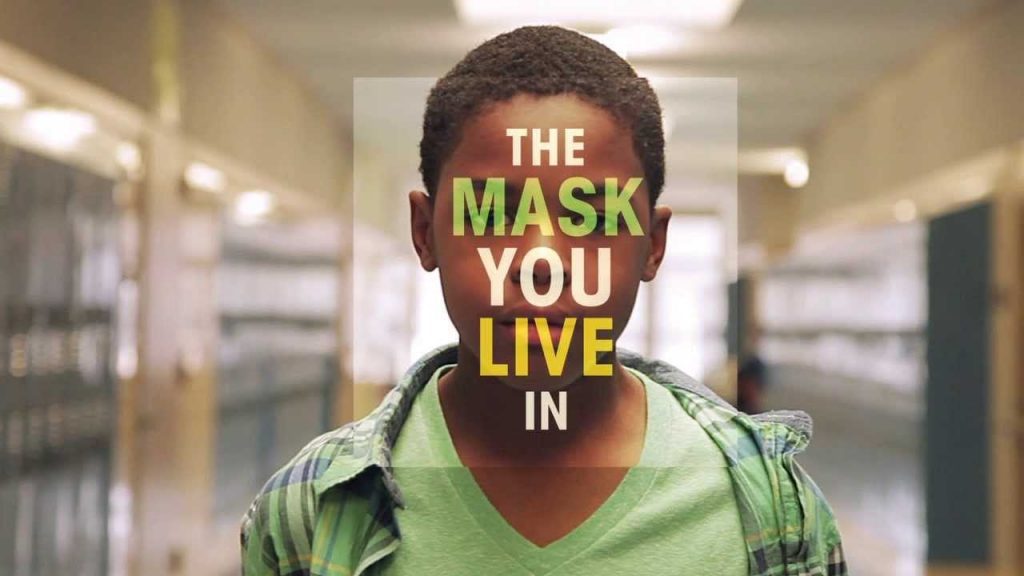The screen opens on an animated scene of a kid in a basement with his father looming over him. A booming voice yells, “be a man.” The animation fades to real life and shows NFL coach and former player, Joe Ehrmann, narrating the story of how his father taught him to “be a man.” Like most boys who grew up in the United States in 1950’s, he was taught early on never to cry, show emotion, or appear weak. This mentally unhealthy way of raising boys is the main topic of the documentary, The Mask You Live In.
The film focuses on the toxic way our society tells boys and men to behave. From adult men to young boys, from parents to educators, the documentary explores how this version of masculinity is hurting the mental health of males in our country. Throughout the film, we see young boys talk about having to hide their emotions, teenagers discussing pressure to appear aggressive, and grown men recounting stories of constant bullying and suicidal thoughts.
These stories aren’t just anecdotes, the statistics back up the heart-felt experiences of these boys and men. According to the film, one in four boys is bullied. Young men are the mostly likely to be both the victims and the perpetrators of gun violence. Young men ages 20-24 are seven times more likely to die from suicide than women of the same age. There is a problem in our society but the good news is that we can help fix it.
The first step to helping with this problem is to become aware of it. As a female viewer, I have been aware of the macho expectations placed on men but I didn’t fully understand how damaging they were nor how early on these expectations can take root in a boy’s life. It upset me to see these boys on screen who were so young but already struggling to open up about their feelings, with one boy even saying, “it feels like I’m not supposed to ask for help.” With no healthy way to express themselves, it is no surprise that many boys feel that violence, substance use, or suicide is the only way to make their emotional pain stop.
The negative consequences of this toxic form of masculinity become even more apparent when The Mask You Live In visits a group of “juvenile lifers” at San Quentin. The group of inmates, who are now adults, are asked to talk about what “being a man” meant in their household. Most of these men described that they learned being a man meant being physically aggressive and domineering while never showing any emotions. One of the inmates describes how it was a combination of abuse, shame, and emotional numbness that led to his previous violent behavior.
Preventing young men from becoming violent or depressed might seem like an impossible task but there are many people working to make a positive change in the lives of young boys and men. Joe Ehrmann strongly believes that coaches and sports teams have the potential to be a source of strength and community for young men. Instead of sports teams being a place where coaches yell insults at the players and winning a game is the entire focus of the sport, Ehrmann wants coaches to be mentors and teammates to be a supportive system. These teams would be built on mutual trust and respect and would encourage boys to grow into men of character who live up to their full potential, not a macho stereotype. Caring community leaders like Ehrmann can be a huge help in raising a generation of boys who are not confined by this unhealthy form of masculinity.
The most powerful scene comes a little more than half way through the documentary. We see another important community leader and teacher, Ashanti Branch, conduct an exercise with a few teenage boys in a group. He gives each of his students a paper mask and asks them to write on one side of the mask what characteristics they show the world and on the other site what they hide from the world. Each student exchanged his mask with another. The masks revealed that almost all of the boys showed “outgoing” and “funny” to the world while hiding “pain” and “anger.” As Ashanti discusses this, we can see one boy become distraught yet his friend comforts him several times. It is moving to see these boys be open and move through some of their emotional issues as they realize they no longer have to wear their masks in front of each other. I invite you all to not only watch this moving documentary but to ask yourself, what is the mask you live in?
You can watch The Mask You Live In (2015) on Netflix as well as purchase the film through Amazon, YouTube and Google Play. This movie is not rated but does contain strong language.
Want the movie?
Click the link below
Your purchase of this film from amazon.com helps support the costs of running rtor.org, a free service of Laurel House, Inc., a 501 (c)(3), nonprofit organization.
The Mask You Live In
Subscribe to our e-newsletter for more mental health and wellness articles like this one.
SUBSCRIBE NOW
Recommended for You
- Living Well with an Eating Disorder - July 18, 2017
- Living Well with Borderline Personality Disorder - June 13, 2017
- 6 Things that Everyone Thinks are Signs of Mental Illness but Aren’t - May 16, 2017




